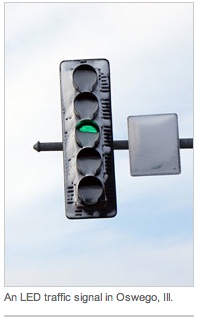This time last year the New York Times reported on safety issues with LED traffic lights in its article called "LED Signals Seen as Potential Hazards". The LED traffic light offer many advantages to cash strapped municipalities - lower operating cost both in terms of power consumption and a tremendously long useful life compared with conventional signal lights. The LED traffic signals reduce the need for DOT personnel to hang precariously in bucket trucks above busy intersections to change the incandescent bulbs. One of the unintended consequences of innovation is that LED signals don't emit much in the way of heat. Lots of work went into making the lights work in the existing signal light housings. To do that you had to eliminate the heat.
The heat from conventional incandescent lamps is what melts the snow on traffic signals. Without the heat from the conventional traffic signal bulbs, snow and ice gets packed into the lights obstructing the lens so that you can't tell what color the light. This results in people having accidents. Tragically some of the accidents resulted in fatalities. To make matters worse, in storm situations only one side of the signal can be obscured - the side with the gusting wind. So one side works and the other doesn't. Not good in a snow storm when one side is working and the drivers on that side follow the lights and the drivers on the other side can't see what's going on with the lights.
The pace for replacing traditional incandescent signals with LED signals is accelerating. Wisconsin, a place with lots of snow, has converted more than 90 percent of the lighting controlled by the state to LED bulbs. So now instead of hanging precariously from bucket trucks to change bulbs, the DOT workers need to hang precariously from bucket trucks in the snow and use brooms to sweep off the snow and ice that obstruct the lenses on the traffic signals.
The LED traffic signal patents almost all tout the benefits of improved energy efficiency and lower cost to operate. Many of the inventions deal with techniques for improved heat dissipation so that the new LED lights can be retrofitted into existing traffic signal housings, and operate better in warmer climates. Others deal with improving the life of the LED lamps by reducing the heat emitted. One would assume from the New York Times article that the heat dissipating means which conduct heat away from the LEDs appear to be working particularly well since snow isn't melting from the lenses.
Enter US Patent 7,211,771 for a Deicing System for Traffic Signals. David Smith and Steven Canan of Precision Solar Controls, Inc. have invented a circuit for detecting and eliminating the buildup of snow and ice on the viewable face of an LED traffic signal lens. One circuit measures ambient temperature, a second transmits a signal when the ambient temperature is below a predetermined level, a third signal receives a reflection of the transmitted signal when frozen matter is present on the LED signal and the fourth signal heats the lens until the ambient temperature on the lens is above the predetermined level or the frozen matter on the lens is eliminated. The patent application was filed in November of 2005 and granted in 17 months on May 1, 2007, pretty quick.. The patent is clear and concise in disclosing the invention without all the vocabulary obfuscation of other patents. Precision Solar Controls has a hot patent in its portfolio and hopefully one that when put into action will eliminate the unintended consequence of LED traffic lights keeping the DOT workers out of the bucket trucks on snowy days. It will no doubt be of benefit in places where snow and ice and traffic lights are a hazardous mix during the winter helping perfect the LED signal light technology. Here in Washington we'll probably just stay home anyway.
*****
Here is a link to Phil Falconer's article at timesunion.com. Another interesting discussion of the problem.
There's lots of information about the art and science of lighting at the Lighting Research Center which is part of Rensselaer Polytechnic Institute in Troy, NY.
The Federal Highway Administration of the US Department of Transportation has information on their latest research and development activities. Check out the Turner-Fairbank Highway Research Center and their research work.
The Federal Highway Administration of the US Department of Transportation has information on their latest research and development activities. Check out the Turner-Fairbank Highway Research Center and their research work.
